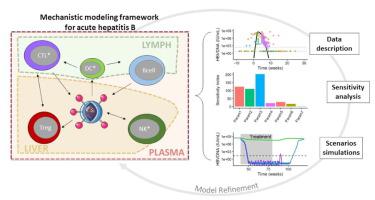Computational and Structural Biotechnology Journal ( IF 6 ) Pub Date : 2021-09-02 , DOI: 10.1016/j.csbj.2021.08.052 Eduardo Asín-Prieto 1, 2 , Zinnia P Parra-Guillen 1, 2 , José David Gómez Mantilla 1, 2 , Joris Vandenbossche 3 , Kim Stuyckens 3 , Xavier Woot de Trixhe 3 , Juan José Perez-Ruixo 3 , Iñaki F Troconiz 1, 2

|
Hepatitis B liver infection is caused by hepatitis B virus (HBV) and represents a major global disease problem when it becomes chronic, as is the case for 80-90% of vertical or early life infections. However, in the vast majority (>95%) of adult exposures, the infected individuals are capable of mounting an effective immune response leading to infection resolution. A good understanding of HBV dynamics and the interaction between the virus and immune system during acute infection represents an essential step to characterize and understand the key biological processes involved in disease resolution, which may help to identify potential interventions to prevent chronic hepatitis B.
In this work, a quantitative systems pharmacology model for acute hepatitis B characterizing viral dynamics and the main components of the innate, adaptive, and tolerant immune response has been successfully developed. To do so, information from multiple sources and across different organization levels has been integrated in a common mechanistic framework. The final model adequately describes the chronology and plausibility of an HBV-triggered immune response, as well as clinical data from acute patients reported in the literature. Given the holistic nature of the framework, the model can be used to illustrate the relevance of the different immune pathways and biological processes to ultimate response, observing the negligible contribution of the innate response and the key contribution of the cellular response on viral clearance. More specifically, moderate reductions of the proliferation of activated cytotoxic CD8+ lymphocytes or increased immunoregulatory effects can drive the system towards chronicity.
中文翻译:

急性乙型病毒性肝炎定量系统药理学模型
乙型肝炎肝脏感染是由乙型肝炎病毒 (HBV) 引起的,当它变成慢性时,代表了一个主要的全球疾病问题,80-90% 的垂直或早期感染就是这种情况。然而,在绝大多数 (>95%) 的成人暴露中,受感染的个体能够产生有效的免疫反应,从而导致感染消退。充分了解急性感染期间 HBV 动态以及病毒与免疫系统之间的相互作用是表征和了解疾病解决所涉及的关键生物学过程的重要一步,这可能有助于确定预防慢性乙型肝炎的潜在干预措施。
在这项工作中,已成功开发了表征病毒动力学和先天性、适应性和耐受性免疫反应的主要成分的急性乙型肝炎定量系统药理学模型。为此,来自多个来源和跨不同组织级别的信息已集成到一个通用机制框架中。最终模型充分描述了 HBV 触发的免疫反应的时间顺序和合理性,以及文献中报道的急性患者的临床数据。鉴于该框架的整体性质,该模型可用于说明不同免疫途径和生物过程与最终反应的相关性,观察先天反应的微不足道的贡献和细胞反应对病毒清除的关键贡献。


























 京公网安备 11010802027423号
京公网安备 11010802027423号